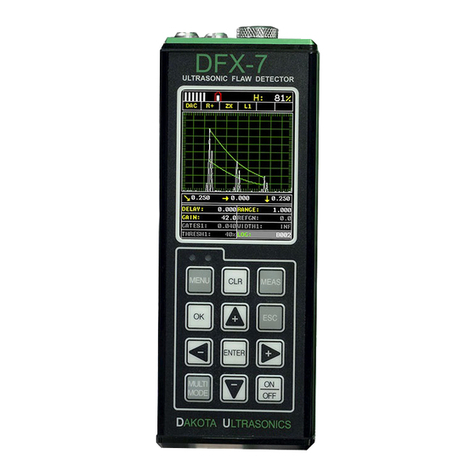
10.3 ESTIMATING EFFECTIVE DIAMETER ................................................................................... 73
10.4 PARAMETER DEFINITIONS DGS(AVG) .............................................................................. 75
10.5 ATTENUATION PARAMETERS ............................................................................................. 76
10.6 CREATING A DGS CURVE ................................................................................................. 77
CHAPTER ELEVEN ADDITIONAL FEATURES OF THE DFX-7 .................... 84
11.1 PULSE WIDTH .................................................................................................................. 84
11.2 PULSE REPETITION FREQUENCY (PRF) ............................................................................ 85
11.3 DAMPING ......................................................................................................................... 86
11.4 PULSER VOLTAGE ............................................................................................................ 87
11.5 MATERIAL VELOCITY CHARTS ........................................................................................... 88
11.6 MATERIAL VELOCITY ........................................................................................................ 89
11.7 ZERO ............................................................................................................................... 90
11.8 BRIGHTNESS .................................................................................................................... 92
11.9 COLOR SCHEME ............................................................................................................... 93
11.10 LANDSCAPE ................................................................................................................... 95
11.11 DIM ............................................................................................................................... 96
11.12 GRAPHICS OPTIONS (LOOK & FEEL) ................................................................................ 97
11.13 DETECT MARK ............................................................................................................... 99
11.14 FILTERS (WIDE & NARROW BANDS) .............................................................................. 100
11.15 GAIN STEP SIZE ........................................................................................................... 101
11.16 DETECT MODES ........................................................................................................... 103
11.17 POLARITY .................................................................................................................... 104
11.18 AUTO FIND ................................................................................................................... 106
11.19 COMPARE .................................................................................................................... 107
11.20 SET DATE & TIME ......................................................................................................... 108
11.21 SHOW DATE & TIME ..................................................................................................... 110
11.22 KEY CLICK ................................................................................................................... 111
11.23 FREEZE & CAPTURE ..................................................................................................... 111
11.24 PEAK HOLD .................................................................................................................. 113
11.25 FREEZE WAVEFORM ..................................................................................................... 114
CHAPTER TWELVE DATA STORAGE – SETUP, EDIT, & VIEW FILES ..... 116
12.1 INTRODUCTION TO GRID AND SEQUENTIAL FILE FORMATS ................................................ 116
12.2 CREATING A NEW GRID OR SEQUENTIAL LOG (FILE) ........................................................ 117
12.3 STORING A WAVEFORM ................................................................................................... 129
12.4 VIEWING STORED READINGS ........................................................................................... 130
12.5 DELETING GRIDS (FILES) ................................................................................................ 132
12.6 EDITING A GRID (FILE) .................................................................................................... 135
12.7 CHANGING THE ACTIVE FILE - OPEN ................................................................................ 137
12.8 CLOSING AN ACTIVE FILE - CLOSE ................................................................................... 139




























